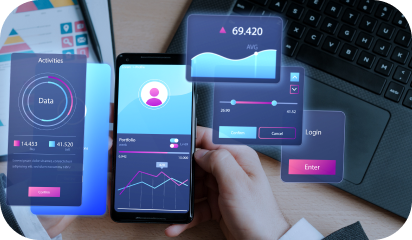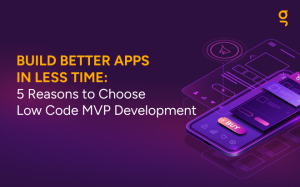No software is perfect, just like humans. But the pursuit of perfection is not futile.
If you look around the web you’ll find thousands, maybe millions of posts telling you how to code, improve performance & stability, scale, and secure your applications. What you might not find is a comprehensive guide that has all the aspects that are needed for a robust mobile application.
In this blog you’ll get to learn about the best practices from design pattern and server setup to coding and security.
Design
Designing is the most crucial stage in an applications development life cycle. Conversions rely heavily on designs and how they’re implemented. Here are some of the best practices that can make your app a usability treat.
- Create efficient onboarding: The goal of onboarding is to show the value of your app to the user by demonstrating how they can achieve what they want in a quick and efficient way. If the user is having trouble within the first few screens, they’ll likely drop off without hesitation.
- Improve usability: Help your users by telling them which icons can be selected, tapped, or swiped. Ensure that you remain consistent with gestures throughout the app to optimize usability, e.g., if swiping up deletes an item, make sure that the same is true for all screens within the app.
- Prioritize actions: For each screen, there should be a primary action. This results in an easy-to-learn interface. You can show prioritization with contrasting colors, different fonts, or buttons.
- Construct a navigation that’s easy and apparent: But, how do I do this? Here are a few points that we follow during our development :
- Don’t hide it — the more obvious it is, the better. Never make a user hunt for it.
- Deliver consistent navigation throughout the app. If you hide it on internal pages, you’ll only add confusion.
- Indicate to users where they are by highlighting their location. This can be a problem for apps as users become “lost” and may abandon the task.
- Utilize a standard navigation platform. For iOS, “Tab Bar” is a good option, while Android works well with “Navigation Drawer.” Stick to simple — it will help you more than spending time on clever.
Scalability
An app that isn’t designed and developed to seamlessly handle continuous growth will eventually end up being a failure. Hence here are some scalability best practices that ensure your app holds up as your business grows.
- Choose the right architecture that way the app can grow organically with increasing traffic to the user base. Based on your needs you can go for MVVM, MVP or MVC pattern.
- When it comes to the server side, it must use “Auto Scaling” so that the server can perform well when the user base grows.
- Try going stateless: Keep APIs stateless. In each request, the client should provide all the information which would be required to fulfill that request. This might not be possible in all cases. Sometimes, we might have to query our database and other services. But try to follow as much as possible.
Security
We know that security is key to putting web/app users’ minds at ease as well as your own! There are six essential security elements that will protect users’ information. If one of these six elements is omitted, then the information is at risk.
- Availability refers to how you’re able to access information or resources in a particular location as well as in the right format. When a system isn’t functioning properly, information and data availability is compromised and it will affect the users.
- Utility isn’t always considered as a pillar in information security, but let’s say that you encrypt one copy of some important information and then the encryption key is accidentally deleted. The information would be available — it just wouldn’t be accessible or usable.
- Integrity references methods of guaranteeing that the data is real, accurate, and protected from any changes from an unauthorized user.
- Authenticity aka “authentication” makes certain that the user’s identity is validated.
- Confidentiality allows authorized users to access sensitive and protected information. Sensitive information and data needs to be disclosed to only authorized users.
- Nonrepudiation is a method of ensuring that message transmissions between parties have a digital signature and/or encryption. A data hash will help you acquire proof of authentic data and data origination.
Cloud and DevOps
Now that almost every app is on cloud with user bases exceeding millions on an average, it is business-critical to have a proper cloud infrastructure and DevOps in place. Here are some practices related to the same.
- Create isolated environment with the help of VPC (virtual private cloud) and define subnet on GCP (Google Cloud Platform) .
- Using IAM(Identity and Access management) services is handy to provide role-based access to any external users.
- For database services, we recommend using cloud SQL.
- For some of our clients, we have used Kubernetes engine for container based hosting.
- Use Continuous Integration (CI) and continuous Delivery/Deployment (CD) to make deployment strategy automatic.
- Using GCP Firewall for server security.
- Configure server environment with auto scaling.
- For email servicing, being experienced in configuring G-Suite will help.
- Use multi-region, load balancer on GCP to route the traffic region wise.
Testing and Optimization
Testing is crucial for a successful project as it enables developers to reveal performance gaps at early stages preventing any development overheads. Based on the identified performance gaps the app can optimized for quality and stability.
- Apply profiling tools for monitoring: Use tools like X-code profiler and Android profiler. With the help of profiling tools, you can detect the crashes and, thereby, get an alternate code against the same instantly.
- Test the app on multiple devices in order to make sure it performs well on most popular devices.
- Prepare for varying network speeds: A mobile user would mostly be using the app on the go, so make sure the app works well in case of switching from WIFI to mobile data or vice versa.
- Optimize queries:
- By optimizing queries, you can control output at the first end, which helps to prevent use of looping, reduce the number of statements, and the excessive use of other controls on the code end. This results in optimal performance for your site.
- Optimizing will create database normalization rules.
Monitoring and Maintenance
Contemporary applications are accessed from different platforms like phones, tablets and desktops. These platforms come with different operating systems, software/hardware platforms, security setups and other limitations. Therefore, continuous application performance monitoring is an essential part for smooth operations.
- Load testing: Check performance of the site with speed test tools, such as GTmetrix, pagespeedtest.org, etc., and implement its suggestions
- Use crash reporting: We recommend integrating a crash reporting tool, such as Fabric Crashlytics
- Make use of short statements — fragmentation of a big function to reduce the same code across multiple places
- Maintain error logs: This helps keep you organized
- Write rules to send email notification to developers/responsible person in case of any issue/error occurs.
Combining the above best practices will help you deliver a site/app above the rest
If the above seems like it’s overwhelming to handle or even for your team to handle alone, reach out to us and we’d be happy to help you in all things related to optimizing your site or app.
Galaxy Weblinks has a dedicated team of designers and developers that are well-versed in creating efficient websites and mobile apps, so reach out to us a

